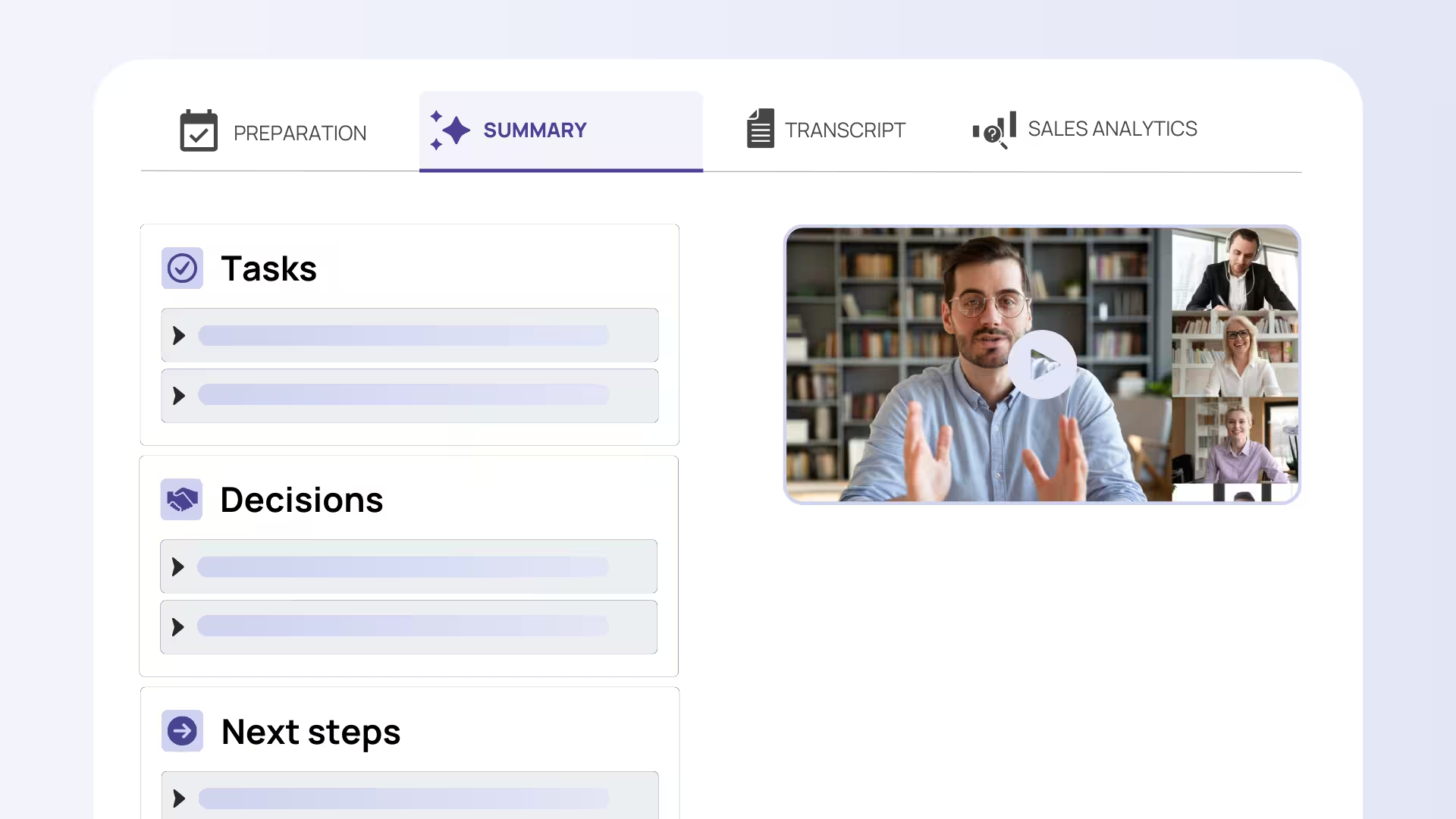Table of Contents
Understanding Status Meetings and Their Importance
Status meetings are regular team gatherings designed to share project updates, discuss progress, and identify potential roadblocks. While these meetings serve as the backbone of project communication in most organizations, they often get a bad reputation for being time-consuming and ineffective.
Teams hold status meetings to maintain alignment, ensure everyone stays informed about project developments, and catch issues before they become major problems. However, many professionals view these gatherings as productivity killers rather than productivity drivers.
When executed properly, status meetings deliver significant benefits: improved communication across team members, better project alignment, and enhanced overall productivity. The key lies in transforming these routine check-ins into focused, purposeful discussions that drive real results. Smart tools like Sally can enhance meeting efficiency through automated transcription and summaries, allowing teams to focus on discussion rather than note-taking.
The Core Purpose of Status Meetings
Defining Status Meetings and Their Objectives
Status meetings serve four primary functions that make them essential for project success. First, they provide quick, regular updates on project progress, ensuring everyone understands where tasks stand. Second, these meetings help surface blockers and challenges early, preventing small issues from becoming major setbacks.
Third, status meetings allow teams to adjust priorities and align tasks based on current circumstances and new information. Finally, they foster transparency and accountability by creating a forum where team members regularly report on their commitments and progress.
The most effective status meetings focus on these core objectives rather than becoming general discussion forums or problem-solving sessions.
Key Benefits to Teams and Projects
Regular status meetings enhance team alignment and shared understanding by ensuring everyone receives the same information simultaneously. This creates a predictable communication cadence that team members can rely on, reducing uncertainty and improving planning.
Over time, these meetings build trust and team cohesion. When team members consistently share updates and challenges openly, it creates psychological safety and strengthens working relationships. Status meetings also support proactive issue resolution by identifying problems early when they're easier to address.
Research from Harvard Business Review shows that teams using regular status meetings for transparency tend to see better morale and engagement over time, demonstrating the long-term value beyond immediate project tracking.

Best Practices for Running Effective Status Meetings
Preparation Is Essential
Successful status meetings start long before participants join the call. Setting a clear agenda and defined objectives before the meeting ensures focused discussions and prevents meandering conversations.
Collecting relevant status updates in advance through project management tools or pre-meeting check-ins saves valuable meeting time. For example, team members can update their progress in Jira or Asana before the meeting, allowing the discussion to focus on blockers and next steps rather than basic updates.
Distributing the agenda and collected updates beforehand allows participants to prepare thoughtful contributions and questions. This preparation transforms the meeting from a reporting session into a strategic discussion.
Tailoring Meetings to Your Audience
Different audiences require different formats and detail levels for optimal effectiveness. Technical teams benefit from detailed, problem-solving focused discussions that dive deep into implementation challenges and solutions. Meanwhile, stakeholders and executives need high-level summaries and key decisions without getting bogged down in technical details.
Frequency adjustments matter too. Daily stand-ups work well for development teams using agile methodologies, while weekly reviews suit most project teams, and monthly stakeholder updates provide sufficient information for leadership oversight without overwhelming busy executives.
The meeting format should match your team's needs and constraints. In-person meetings work best for complex discussions requiring collaboration, video calls suit distributed teams, and asynchronous updates can handle routine status sharing efficiently.
Time Management and Efficiency Techniques
Timeboxing agenda items strictly prevents overruns and keeps meetings focused. Allocate specific time slots for each topic and stick to them, moving offline discussions that exceed their time allocation.
Encourage concise, clear communication by establishing ground rules about update length and format. A simple structure like "what I completed, what I'm working on next, and what's blocking me" keeps contributions focused and valuable.
Utilize facilitation techniques to keep participants engaged, such as rotating speaking order, using visual aids, and asking specific questions. Tools like Sally can automate note-taking and summarize action items, freeing the facilitator to focus on guiding discussion rather than documentation.

Common Challenges and How to Overcome Them
Addressing Meeting Fatigue and Overload
Meeting fatigue becomes a serious problem when teams schedule unnecessary or excessive status meetings. Avoid the trap of holding meetings simply because they're scheduled. Regularly evaluate whether each meeting serves a genuine purpose or has become a routine check-in without value.
Make meetings purposeful by combining status updates with problem-solving activities. When team members share blockers, immediately discuss potential solutions or assign follow-up actions. This approach increases the meeting's value and makes participation feel worthwhile.
Consider reducing frequency or duration before adding more meetings. Sometimes a 15-minute focused discussion delivers more value than a 60-minute comprehensive review.
Ensuring Engagement and Participation
Create a safe space for honest updates and blockers by establishing psychological safety. Team members should feel comfortable admitting challenges without fear of judgment or negative consequences.
Rotate meeting roles to boost involvement and prevent the same person from always facilitating. Assign different team members to lead discussions, take notes, or track action items. This rotation increases engagement and develops leadership skills across the team.
Use interactive tools, especially for virtual meetings, to maintain engagement. Polls, chat features, and breakout rooms can reenergize discussions and ensure everyone participates actively.
Continuous Improvement Through Feedback
Implement feedback loops through surveys, retrospectives, and informal check-ins to understand how participants perceive meeting effectiveness. Anonymous feedback often reveals issues that team members hesitate to share openly.
Adjust format, frequency, and content based on participant input. Teams that regularly iterate on their meeting structure see better attendance and engagement compared to those using static formats.
Encourage openness to change and experimentation. Try new approaches for a few weeks, gather feedback, and adjust accordingly. This iterative approach helps meetings evolve with team needs and project requirements.
Leveraging Technology and Culture for Better Status Meetings
Integrating Digital Tools for Seamless Meetings
Modern project management platforms like Jira, Trello, and Asana can track status and automate updates, reducing meeting time spent on basic reporting. Teams can review progress visually during meetings rather than listening to individual reports.
Video conferencing combined with transcription and summary tools like Sally enables better documentation and follow-up. Participants can focus on discussion knowing that decisions and action items are being captured automatically.
Visual dashboards help focus discussion and highlight key metrics. Instead of verbal reports, teams can review charts and graphs that immediately show progress, bottlenecks, and trends.

Adapting to Organizational Culture
Company culture significantly shapes meeting preferences and effectiveness. Formal organizations may require structured agendas and documented outcomes, while informal cultures might benefit from conversational, flexible formats.
High-power distance cultures often need more structured meeting hierarchies, while flat organizations benefit from open, democratic discussions where any team member can contribute equally.
Encourage cultural sensitivity and inclusivity in multinational teams by considering time zones, communication styles, and cultural norms around hierarchy and feedback.
The Long-Term Impact of Effective Status Meetings
Well-run status meetings contribute to sustained team morale and trust by creating predictable communication patterns and shared understanding. Teams that communicate regularly and transparently develop stronger working relationships.
These meetings play a crucial role in fostering accountability and psychological safety. When team members consistently share both successes and challenges, it creates an environment where people feel supported and responsible for their commitments.
Status meetings support continuous alignment and strategic agility over time. Teams that stay connected through regular updates can pivot quickly when priorities change and maintain focus on shared objectives.
Conclusion: Transform Your Status Meetings into Productivity Drivers
Effective status meetings require thoughtful preparation, audience-appropriate tailoring, clear communication, smart technology integration, and continuous feedback. The key insight is that these meetings aren't just updates—they're tools for building aligned, motivated teams that work together effectively.
Start by evaluating your current status meetings honestly. Are they serving their intended purpose? Do participants find them valuable? Are you using the right format and frequency for your team's needs?
Transform your approach by implementing the best practices outlined here: prepare thoroughly, tailor to your audience, manage time strictly, address challenges proactively, and leverage technology wisely. Consider automation tools like Sally to save time and enhance meeting quality, allowing your team to focus on discussion rather than documentation.
Remember that great status meetings evolve with your team's needs. Stay open to feedback and experimentation, and don't be afraid to adjust your approach as projects and teams change. With consistent effort and the right practices, your status meetings can become powerful drivers of team productivity and alignment.

Try meeting transcription now!
Experience how effortless meeting notes can be – try Sally free for 4 weeks.
Test NowOr: Arrange a Demo Appointment

.avif)


